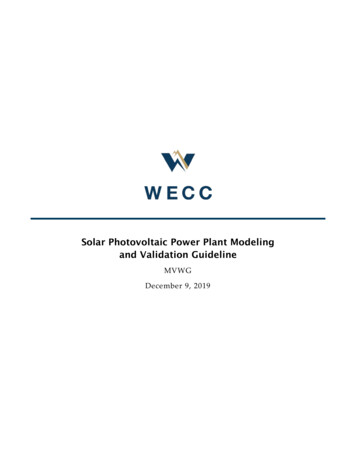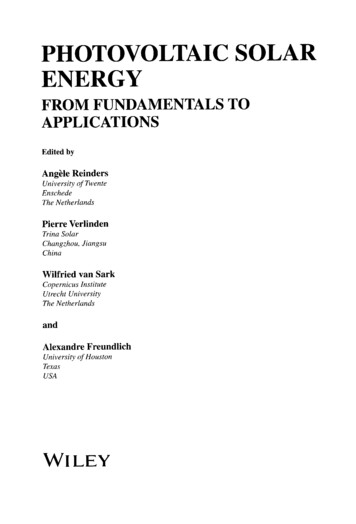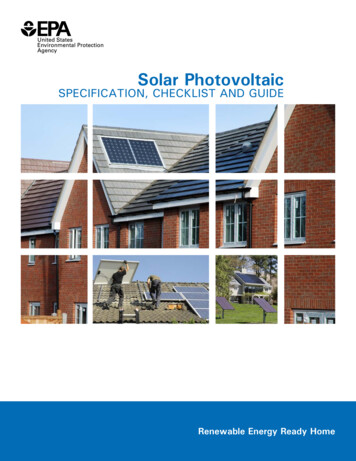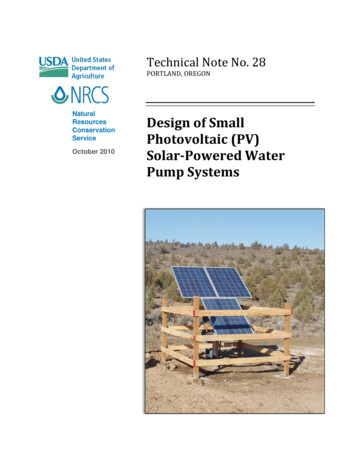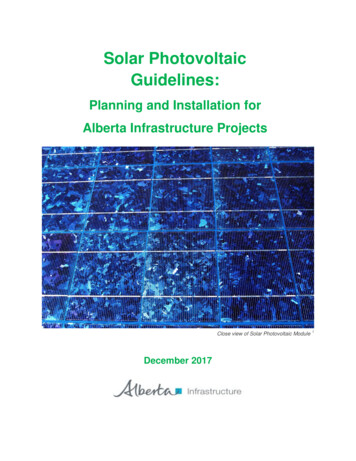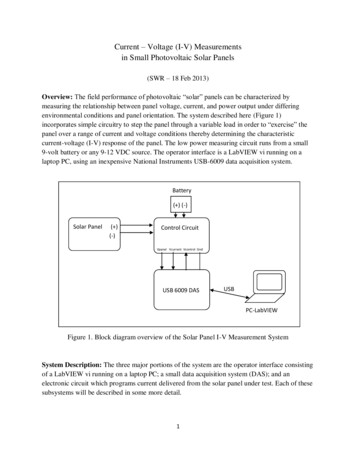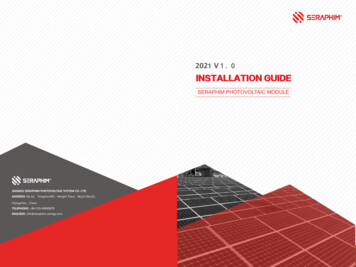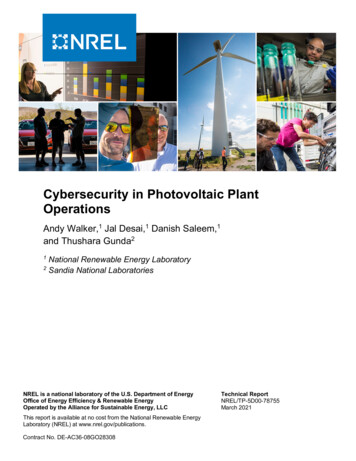
Transcription
Cybersecurity in Photovoltaic PlantOperationsAndy Walker,1 Jal Desai,1 Danish Saleem,1and Thushara Gunda212National Renewable Energy LaboratorySandia National LaboratoriesNREL is a national laboratory of the U.S. Department of EnergyOffice of Energy Efficiency & Renewable EnergyOperated by the Alliance for Sustainable Energy, LLCThis report is available at no cost from the National Renewable EnergyLaboratory (NREL) at www.nrel.gov/publications.Contract No. DE-AC36-08GO28308Technical ReportNREL/TP-5D00-78755March 2021
Cybersecurity in Photovoltaic PlantOperationsAndy Walker,1 Jal Desai,1 Danish Saleem,1and Thushara Gunda212National Renewable Energy LaboratorySandia National LaboratoriesSuggested CitationWalker, Andy, Jal Desai, Danish Saleem, and Thushara Gunda. 2021. Cybersecurity inPhotovoltaic Plant Operations. Golden, CO: National Renewable Energy Laboratory.NREL/TP-5D00-78755. https://www.nrel.gov/docs/fy21osti/78755.pdf.NREL is a national laboratory of the U.S. Department of EnergyOffice of Energy Efficiency & Renewable EnergyOperated by the Alliance for Sustainable Energy, LLCTechnical ReportNREL/TP-5D00-78755March 2021This report is available at no cost from the National Renewable EnergyLaboratory (NREL) at www.nrel.gov/publications.National Renewable Energy Laboratory15013 Denver West ParkwayGolden, CO 80401303-275-3000 www.nrel.govContract No. DE-AC36-08GO28308
NOTICEThis work was authored in part by the National Renewable Energy Laboratory, operated by Alliance for SustainableEnergy, LLC, for the U.S. Department of Energy (DOE) under Contract No. DE-AC36-08GO28308. Fundingprovided by U.S. Department of Energy Office of Energy Efficiency and Renewable Energy Solar EnergyTechnologies Office Award Number 34172. The views expressed herein do not necessarily represent the views ofthe DOE or the U.S. Government.This report is available at no cost from the National RenewableEnergy Laboratory (NREL) at www.nrel.gov/publications.U.S. Department of Energy (DOE) reports produced after 1991and a growing number of pre-1991 documents are availablefree via www.OSTI.gov.Cover Photos by Dennis Schroeder: (clockwise, left to right) NREL 51934, NREL 45897, NREL 42160, NREL 45891, NREL 48097,NREL 46526.NREL prints on paper that contains recycled content.
AcknowledgmentsThis material is based upon work supported by the U.S. Department of Energy’s Office ofEnergy Efficiency and Renewable Energy (EERE) under the Solar Energy Technologies Office(SETO) Award Number 34172. The contributions and review of John Franzino, vice president ofGrid Security at Grid SME, are gratefully acknowledged.Sandia National Laboratories is a multimission laboratory managed and operated by NationalTechnology and Engineering Solutions of Sandia, LLC, a wholly owned subsidiary ofHoneywell International, Inc., for the U.S. Department of Energy's National Nuclear SecurityAdministration under contract DE‐NA‐0003525.This report was prepared as an account of work sponsored by an agency of the United StatesGovernment. Neither the United States Government nor any agency thereof, nor any of theiremployees, makes any warranty, express or implied, or assumes any legal liability orresponsibility for the accuracy, completeness, or usefulness of any information, apparatus,product, or process disclosed, or represents that its use would not infringe privately owned rights.Reference herein to any specific commercial product, process, or service by trade name,trademark, manufacturer, or otherwise does not necessarily constitute or imply its endorsement,recommendation, or favoring by the United States Government or any agency thereof. The viewsand opinions of authors expressed herein do not necessarily state or reflect those of the UnitedStates Government or any agency thereof.iiiThis report is available at no cost from the National Renewable Energy Laboratory at www.nrel.gov/publications.
List of OTPVSCADASPCybersecurity and Infrastructure Security Agencydistributed energy resourceDistributed Energy Resource Cybersecurity FrameworkU.S. Department of Homeland SecurityU.S. Department of EnergyFederal Information Processing StandardsInternational Electrotechnical CommissionInstitute of Electrical and Electronics Engineersinformation technologyNorth American Electric Reliability CorporationNational Institute of Standards and TechnologyNational Security Agencyoperational technologyphotovoltaicsupervisory control and data acquisition systemSpecial PublicationivThis report is available at no cost from the National Renewable Energy Laboratory at www.nrel.gov/publications.
Table of Contents1Introduction . 11.11.2Background and Context . 3Current and Common Threats for Operators of Photovoltaic Plants. 32 Challenges Faced by Photovoltaic Plant Operators in Implementing Cybersecurity . 53 Cybersecurity Standards That Apply to Photovoltaic Plant Operations . 64 Cybersecurity Response Plan for Photovoltaic Plant Operations . 85 Best Practices and Additional Protective Steps to Ensure Photovoltaic Plant Cybersecurity . 96 Cost of Cybersecurity Measures in Operation of Photovoltaic Plants . 127 Conclusion . 13References . 14vThis report is available at no cost from the National Renewable Energy Laboratory at www.nrel.gov/publications.
1 IntroductionHistorically, the centralized power plants and vertically integrated utilities that comprised theelectric grid had dedicated control systems and communications methods that allowed for remoteoperation and maintenance to occur without much regard or concern to cybersecurity risks.Photovoltaic (PV) systems, however, increasingly rely on common information technology (IT)computing and networking infrastructure as well as the Internet to perform all aspects ofoperation and maintenance, including but not limited to revenue metering, monitoring ofcondition, remote diagnostics, aggregation in virtual power plants, and control of grid supportfeatures such as curtailment and control of reactive power (Teymouri, Mehrizi-Sani, and Liu2019). The transition of PV plant operations to an Internet-based world introduces many newsecurity threats to the electric grid—including stealing or rerouting funds; denial of service;breaching confidential or proprietary information from a company, its customers, its suppliers;ransomware that denies operation of automated equipment for payment; and malicious controlactions that could damage equipment and endanger personnel. Hackers intercept sensor controlcommunications or use phishing and spoofing to obtain initial access and then use sophisticatedmeans to escalate their access privileges for profit or to wreak havoc. Damage is not limited tointerruption in operations or even plant equipment; it could extend to the electric grid, which wasnot originally designed for variable generation and bidirectional power flow.The sophistication and resources available to an attacker have also evolved to include advancedand persistent threats. Unsophisticated attacks occur because a vulnerability exists and is takenadvantage of by an attacker. Motivation for the attack is for entertainment or to be a nuisance.More sophisticated attackers seek to exploit your vulnerability motivated by monetary gain, theinformation has other value (reputation), or to cause damage. Corporate espionage is motivatedby gaining access to your business plans, pricing, and intellectual property to gain a competitiveedge through spying. Advanced and persistent threats can be either state-sponsored or throughother sophisticated attackers with advanced capabilities and resources. They seek data and thecapability to weaponize distributed energy resource (DER) systems. They can progress frominitial infiltration to privilege escalation, to intelligence gathering, to data extraction, and tousurping communications and command/control actions. Vulnerabilities may be introduced inthe supply chain, maliciously inserted into purchased software and hardware from networkmanagement software to software applications and down to the firmware and chipsets of devices.Stakeholders such as PV plant operators and utilities, providers of network equipment, standardsmaking organizations, and others are addressing cybersecurity threats with a “Roadmap for PVSystem Cyber Security” (Johnson 2017) that share industry best practices, prioritize researchtopics; and advance developments in standards.Rapid developments in IT exploit vulnerabilities in legacy systems but also can be used to makecertain types of attack impossible. Legacy systems are vulnerable to certain types of attacksbecause of the rapidly advancing capability of IT exploits; however, these advances also includenew ways to prevent attacks, based on commercial cloud security initiatives; mobile and “edge”computing; 5G telecommunications (which allow “slicing” of data); and quantum computing(which allows truly random number generation copy-proof communications, and fast machinelearning of attack methods). This paper examines cybersecurity from the perspective of the PV1This report is available at no cost from the National Renewable Energy Laboratory at www.nrel.gov/publications.
plant operator, compliance with adherence to standards, roles and responsibilities, best practices,and strategies to deal with an ever-evolving threat landscape.2This report is available at no cost from the National Renewable Energy Laboratory at www.nrel.gov/publications.
1.1 Background and ContextCybersecurity is central to issues of web use, data protection, and technology development.Beyond its most traditional applications, it could also be critical to instances of policydevelopment, legal protection, health care, and education. The inherent interdisciplinary featuresof cybersecurity pose difficulty in defining it clearly. Craigen, Diakun-Thibault, and Purse(2014) agreed on the following definition: “Cybersecurity is the organization and collection ofresources, processes, and structures used to protect cyberspace and cyberspace-enabled systemsfrom occurrences that misalign de jure from de facto property rights.” Because web-basedinteractions are embedded in modern-day existence, researchers suggest the value of a shareddoctrine of public security that outlines both the goals (policy creation) and means (regulatorymeasures) to uphold and protect cybersecurity (Mulligan and Schneider 2011).Cybersecurity and Infrastructure Security Agency (CISA), the U.S. Department of HomelandSecurity’s (DHS) newly created cybersecurity branch, highlights the importance of cybersecurityto national defense. Among its aims, DHS outlines strategies such as disruption to criminal useof the cyberspace, cyber incident response, and strengthened security of cyber activities (DHS2019). Cybersecurity protections have been evolving for decades in instances of federal privacylegislation (i.e., Health Insurance Portability and Accountability Act, Children’s Online PrivacyProtection Act, Fair Credit Reporting Act), executive branch actions to ensure user privacy, andthe U.S. Supreme Court’s recent decision to extend constitutional rights to data held by thirdparties (Raul 2018).The “roadmaps” for PV cybersecurity and Distributed Energy Resources cybersecurity engagestakeholders to share best practices, prioritize research and development needs, and steer newstandards development (Johnson 2017, 2019). Cybersecurity is a topic that cuts across severalagencies’ domain and the roadmap effort is applauded by providing a high level of cooperationbetween stakeholder through a “working group” structure.1.2 Current and Common Threats for Operators of PhotovoltaicPlantsCybersecurity incidents can take any form and some common types include: spearphishing toaccess an IT network and gain entry to the operational technology (OT) network; deployingsoftware to encrypt data for ransom or to hamper operations; and accessing controllers thatrequire no authentication for access or that communicate via commonly used ports and standardapplication layer protocols and modifying the control logic. Consequences of these kinds ofincidents include a loss of visibility for human operators and resulting loss of operations(unavailability), loss of production, and loss of revenue (NSA and CISA 2020).The first publicly reported cyberattack on a solar installation involved the exploitation of aknown vulnerability in the firewall of commercial network software. In May 2019, a utility in thewestern United States reported to the U.S. Department of Energy (DOE) that they had beencompromised by a denial-of-service cyberattack that targeted the company’s firewall. The maincause of the attack was an unpatched Cisco firewall that gave hackers the ability to exploit thevulnerability and crash the device. This attack broke the connection between the utility’s windand solar power generation installations and caused a temporary disruption in its supervisorycontrol and data acquisition (SCADA) systems, resulting in a series of 5-minute communications3This report is available at no cost from the National Renewable Energy Laboratory at www.nrel.gov/publications.
outages between the independent power producer’s grid control center in Utah and its generationfacilities. The impacted generation totaled 500 MW, including a 106.3-MW PV project inCalifornia and an 80-MW wind power plant in Wyoming. The operator was not able tocommunicate with the plants for 12 hours, but the plants continued to operate autonomously, andno other consequences—such as a breach of data—were reported. This appears to be a crime ofopportunity, with the hacker motivated by the vulnerable firewall rather than to attack thisspecific company (Sobczak 2017). 1 Later reports revealed that a Utah-based renewable energyprovider, sPower, was the victim of this cyberattack (WETO 2020). It is said to be the first-ofits-kind attack to hit a renewable energy provider—and disconnecting a U.S. electric gridoperator from its power generation station.Cyberattacks against utilities are increasing in frequency and severity. North American ElectricReliability Corporation (NERC) President and Chief Executive Officer, Jim Robb, said that “thethreat of a cyberattack is at an all-time high” (NERC 2019). According to the Global State ofInformation Security Survey 2015, the number of detected cyber incidents by power companiesand electric utilities around the world had increased six times compared to the previous year. InFiscal Year 2014, of the 245 total incidents reported to Industrial Control Systems CyberEmergency Response Team, among all sectors, 55% involved advanced persistent threats orsophisticated actors, with 32% of incidents reported by energy sector companies (PWC 2014).Duke Energy, which serves nearly 8 million U.S. customers, reported more than 650 millionattempted cyberattacks in 2017 alone (Diagle 2018)).Attacks in other parts of the world indicate the vulnerabilities that exist in the cyber realm. Forexample, in 2016, cyberattacks on Kiev, Ukraine, left hundreds of thousands of civilians withoutpower on several different occasions, representing the unrelenting threats posed to moderncybersecurity (Lee, Assante, and Conway 2016). Also, a cyber war by the “WannaCrypt” wormin May 2017 impacted 59,000 computers in nearly 100 countries, leaving negative economic andoperational impacts in its wake (Venkatachary, Prasad, and Samikannu 2018). Despite fewexamples of infrastructural hacking in the United States, cybersecurity experts believe “we havebeen incredibly lucky that there hasn’t been a catastrophic cyberattack against nationalinfrastructure” (Smith 2018)—which suggests the issue is much less of an “if” and more of a“when.”A review of cyber-related entries within Sandia National Laboratories’ PV Reliability Operationsand Maintenance database (Gunda and Homan 2020) revealed additional insights. Operationand-maintenance tickets discuss cybersecurity training, troubleshooting of firewall issues, andcybersecurity software updates; however, no reports of actual attacks were captured within thelogs. This could be because cyber issues are treated separately from other physical maintenanceand not reported in the computerized maintenance management systems. It is also possible thatcyberattacks often go unrecognized or unreported.This article includes a link to the original DOE Office of Electricity Delivery and Energy Reliability ElectricityEmergency Incident and Disturbance Report.14This report is available at no cost from the National Renewable Energy Laboratory at www.nrel.gov/publications.
2 Challenges Faced by Photovoltaic Plant Operatorsin Implementing CybersecurityChallenges cited by PV plant operators include a lack of personnel with cybersecurity expertiseto counter the threat. Also cited is a lack of cyber hygiene, such as weak passwords, outdatedsecurity software, and failure to frequently back up data. PV plants are most often unattended,making it costly and slow to get manual confirmation of a reported anomaly in a sensor readingor control setting.Energy systems integration necessitates decentralized monitoring and control of distributedgeneration assets such as PV systems. Information must be passed around to provide ramp ratecontrol, voltage regulation, fault identification and isolation, and configuration of circuits. Eachcomponent introduces a point of vulnerability: advanced meters, inverter controls, dataacquisition and communications, building or facility energy management systems, weathermonitoring, field sensors such as voltage measurements, actuators such as reclosers, andcommunications related to safety systems.Overcoming these challenges involves plans that encompass this extended threat surface, trainingfor staff, and certifications for security systems.5This report is available at no cost from the National Renewable Energy Laboratory at www.nrel.gov/publications.
3 Cybersecurity Standards That Apply to PhotovoltaicPlant OperationsThe “Roadmap for PV Cyber Security” outlines a 5-year strategy for DOE, industry, andstandards development organizations (Johnson 2018). The roadmap describes working groupstakeholder engagement, research, and development priorities; best practices; and cybersecuritycodes and standards to protect infrastructure, detect threats, recover from attacks, hardeninfrastructure, conduct self-evaluations, and practice good cyber hygiene and employeeawareness (Johnson 2017). Similarly, the “certification procedure for cybersecurity of DERs,”funded by DOE SETO, provides test cases that can be used by vendors, utilities, certificationlabs, government organizations, and industry partners to validate the cybersecurity posture of theexisting and upcoming DERs.Cybersecurity standards for solar PV are still at a very nascent stage, but a lot of work is alreadygoing on in this space. Broad working groups comprising industry, federal laboratories,universities, state energy officials, and standard development organizations are formed todevelop consensus-based cybersecurity policies that could be applicable to a large number ofsystems and a nationally accredited certification standard for those functionalities (NARUC202
This report was prepared as an account of work sponsored by an agency of the United States Government. Neither the United States Government nor any agency thereof, nor any of their . features such as curtailment and control of reactive power (Teymouri, Mehrizi-Sani, and Liu . legislation (i.
